- Photo Safaris
- Alaska Bears & Puffins World's best Alaskan Coastal Brown Bear photo experience. Small group size, idyllic location, deluxe lodging, and Puffins!
- Participant Guestbook & Testimonials Candid Feedback from our participants over the years from our photo safaris, tours and workshops. We don't think there is any better way to evaluate a possible trip or workshop than to find out what others thought.
- Custom Photo Tours, Safaris and Personal Instruction Over the years we've found that many of our clients & friends want to participate in one of our trips but the dates we've scheduled just don't work for them or they'd like a customized trip for their family or friends.
- Myanmar (Burma) Photo Tour Myanmar (Burma) Photo Tour December 2017 -- with Angkor Wat option
- Reviews Go hands-on
- Camera Reviews Hands-on with our favorite cameras
- Lens reviews Lenses tested
- Photo Accessories Reviews Reviews of useful Photo and Camera Accessories of interest to our readers
- Useful Tools & Gadgets Handy tools and gadgets we've found useful or essential in our work and want to share with you.
- What's In My Camera Bag The gear David Cardinal shoots with in the field and recommends, including bags and tools, and why
- Articles About photography
- Getting Started Some photography basics
- Travel photography lesson 1: Learning your camera Top skills you should learn before heading off on a trip
- Choosing a Colorspace Picking the right colorspace is essential for a proper workflow. We walk you through your options.
- Understanding Dynamic Range Understanding Dynamic Range
- Landscape Photography Tips from Yosemite Landscape Photography, It's All About Contrast
- Introduction to Shooting Raw Introduction to Raw Files and Raw Conversion by Dave Ryan
- Using Curves by Mike Russell Using Curves
- Copyright Registration Made Easy Copyright Registration Made Easy
- Guide to Image Resizing A Photographers' Guide to Image Resizing
- CCD Cleaning by Moose Peterson CCD Cleaning by Moose Peterson
- Profiling Your Printer Profiling Your Printer
- White Balance by Moose Peterson White Balance -- Are You RGB Savvy by Moose Peterson
- Photo Tips and Techniques Quick tips and pro tricks and techniques to rapidly improve your photography
- News Photo industry and related news and reviews from around the Internet, including from dpreview and CNET
- Getting Started Some photography basics
- Resources On the web
- My Camera Bag--What I Shoot With and Why The photo gear, travel equipment, clothing, bags and accessories that I shoot with and use and why.
- Datacolor Experts Blog Color gurus, including our own David Cardinal
- Amazon Affiliate Purchases made through this link help support our site and cost you absolutely nothing. Give it a try!
- Forums User to user
- Think Tank Photo Bags Intelligently designed photo bags that I love & rely on!
- Rent Lenses & Cameras Borrowlenses does a great job of providing timely services at a great price.
- Travel Insurance With the high cost of trips and possibility of medical issues abroad trip insurance is a must for peace of mind for overseas trips in particular.
- Moose Peterson's Site There isn't much that Moose doesn't know about nature and wildlife photography. You can't learn from anyone better.
- Journeys Unforgettable Africa Journeys Unforgettable -- Awesome African safari organizers. Let them know we sent you!
- Agoda International discounted hotel booking through Agoda
- Cardinal Photo Products on Zazzle A fun selection of great gift products made from a few of our favorite images.
- David Tobie's Gallery Innovative & creative art from the guy who knows more about color than nearly anyone else
- Galleries Our favorite images
Skill & Luck: A Good Photo Strategy does not equal Photo Success
Skill & Luck: A Good Photo Strategy does not equal Photo Success
Submitted by David Cardinal on Fri, 04/02/2010 - 10:15
When a pro photographer is paid to shoot a product or model in a studio they are judged by their results—which makes perfect sense because they have control of nearly all the variables involved. Barring a natural disaster or a series of unforseeable equipment failures they should be able to deliver the goods. But applying the same expectations to wildlife and even other kinds of action photography is a recipe for disappointment…
Far too often it is easy to judge a day in the field a failure because good images were few and far between. But if we hold ourselves to that standard then we’re off on the wrong track because we’ll be measuring our luck as much as our skill and strategy. Even if we have worked hard to give ourselves the best chance at the ‘right’ light, the ‘right’ subjects all in the ‘right’ environment we can’t control the weather or our subjects. If you can, it’s not wildlife! When you have a good plan and it doesn’t work it doesn’t make the plan bad, it just means your luck didn’t work out that day.
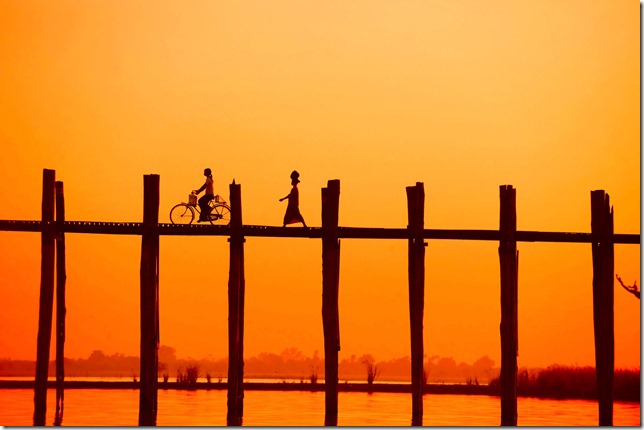
Believe it or not this image from Burma is mostly skill.
Join us on our Southeast Asia Safari and find out why—and get similar ones of your own.
Conversely we can stumble across unique opportunities that we hadn’t planned for in the least and walk away with the shot of a lifetime totally unexpectedly. That’s not strategy, it’s good luck. Nothing wrong with that but if you confuse good luck with good strategy you can be in for a lot of depressing days when things don’t go your way. As a sidebar it is one big problem with using ‘single image’ photo contests as a measure of photographic skill. Of course it requires good skills and a good eye to make great images but often the winning image required a huge amount of luck (like the trap camera shot that won the BBC contest last year). “Pro Tour” type contests which require a time and a portfolio shot under prescribed conditions are certainly a better indicator, although of course there too luck plays a part in the best images.
So the trick with wildlife photography is to understand the difference between preparation, planning, execution and luck and be willing to evaluate each session of your photography honestly to decide what you could have done differently if anything and whether your strategy is the right one you should stick with or can be modified.
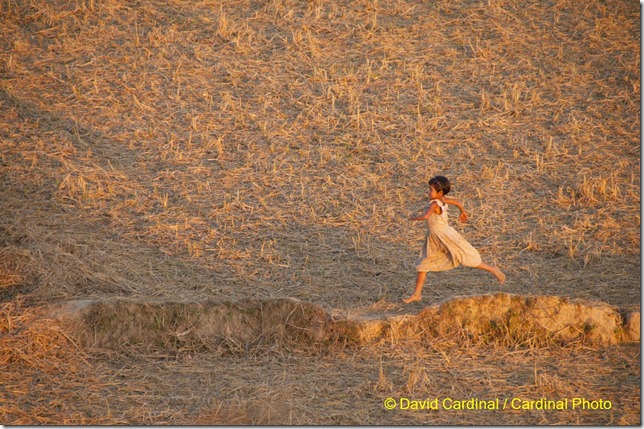 This image was pretty much luck.
This image was pretty much luck.
We had great light and were photographing the temples of Mrauk U in Burma at sunset
when this impish girl came running across the rice paddy.
The only skill consisted of recognizing, framing and taking the shot before she was gone.
On every photo safari where we have more than one vehicle it seems like there is always at least one participant who is sure they were always in the “right” vehicle and at least one who is sure they were always in the “wrong” vehicle. They’re usually both half-right. It can make for interesting dinner conversation and is a reason we try to keep our groups small so everyone has plenty of great opportunities even if we have a limited number of subjects. There is always an occasion where you watch someone nearby getting a shot you wished you had and regret not being where they are. That’s particularly true if your view of the subject isn’t very good right at that minute so you are sitting and fretting. But two minutes later when the leopard of your dreams moves over to your side of the tree and you’ve got the hammer down and are blazing through dozens of great frames you don’t notice that same person staring glumly at you.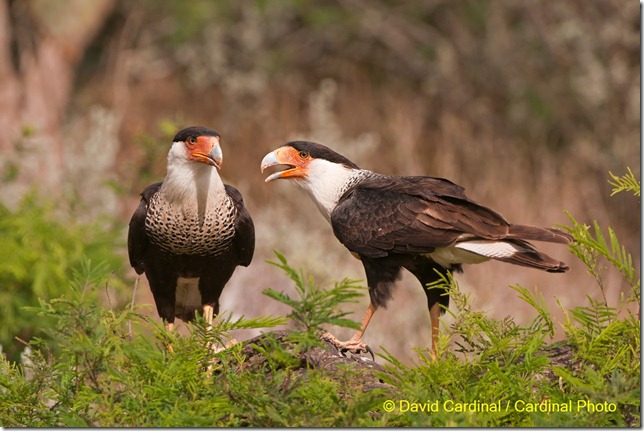
Skill or Luck?
Being on a well-run photo ranch that I’d used before at the right time of day was skill
Having the two Crested Caracara show up was likely. Having them pose was of course luck.
We’ve still got openings for our South Texas and Texas Hill Country safaris this month!
But if you really aren’t in the right place much of the time, or you really can’t find your subjects very often, then it is completely fair to ask yourself if you’re doing something wrong. Better yet, ask someone else. Sign up for a small group photo safari that includes in the field instruction and end of day image critiques with someone who is an expert and learn from them, or politely approach someone whose images of that same subject impress you and see if they’ll share some tips. Most of the time you’ll find they’ll at least give you some general ideas and guidance. If you’re after wildlife the one must have book is Moose Peterson’s Wildlife Photography book. Updated for digital it is full of hundreds of tactics and tips for getting great images without breaking the bank or endangering any animals. Moose’s book includes plenty on bird photography, but Art Morris’s e-Book on bird photography is a great resource exclusively about that subject. For landscapes nearly anything by John Shaw is a good read, especially John Shaw's Nature Photography Field Guide.
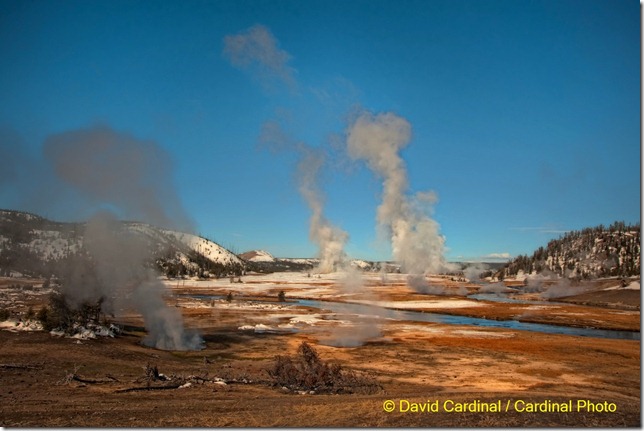 All the skill in the world can’t guarantee a blue sky in Winter in Yellowstone.
All the skill in the world can’t guarantee a blue sky in Winter in Yellowstone.
But it can put you in the right place for when it happens.
We all have stories about how strategy and luck have collided one way or the other. One of my favorite (now) is my hunt for small and often elusive burrowing owls, an endangered species here in California. I’d photographed them in Florida, but for some reason no matter how many sightings I responded to near where I live I was never able to get any good opportunities. I was doing all the right things including monitoring birding lists and in some cases even going out with biologists who were studying them. Then, after I’d driven half way across the state and gotten permission to go into some locked property and finally got a few images a family of nine of them moved into a burrow 10 yards from a road near my house and provided day after day of point blank images. Had my strategy changed? No, but my luck had.
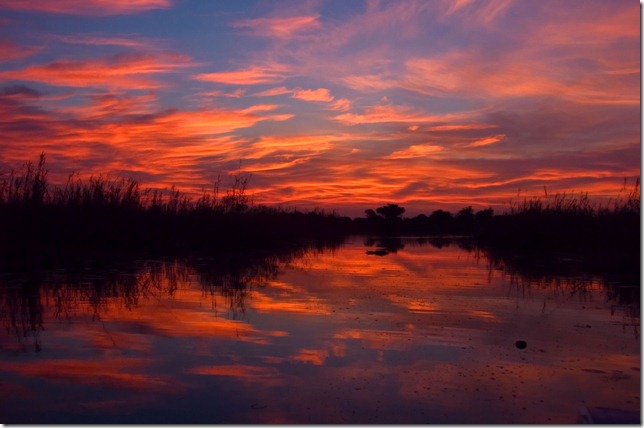 This gorgeous sunrise over the Okavango Delta is not a difficult image to get, …
This gorgeous sunrise over the Okavango Delta is not a difficult image to get, …
if you know exactly where to be and when. Most groups never see it. The pink light only lasts for a minute or two
Join us for our May, 2011 trip to Botswana for plenty of great photo opportunities.
The biggest lesson in all this is to approach each day shooting nature and wildlife as a day for learning and learning about yourself. Pay attention to what works and what doesn’t and think about why and whether you’d make the same choices over again. Is that beach you love for sandpipers too foggy too often? Is there another one you can try that has better weather? Or did a dog chase your birds away just as you were getting some good shots? Is that a one off or are there usually dogs on that stretch of beach?
If you’d like to learn more about choosing a photo safari or workshop and or how to plan your own, I’m giving a talk and slideshow on the topic at the Bay Area Bird Photographers on April 7th in Palo Alto, California at 7:30pm at the Lucy Evans Baylands Nature Center. And of course please do browse our photo safari calendar for unique small group photo trips where learning and photo fun are equal priorities. Our sister site, nikondigital.org also has a great set of forums with lots of experienced photographers ready to answer questions.
- Log in to post comments

